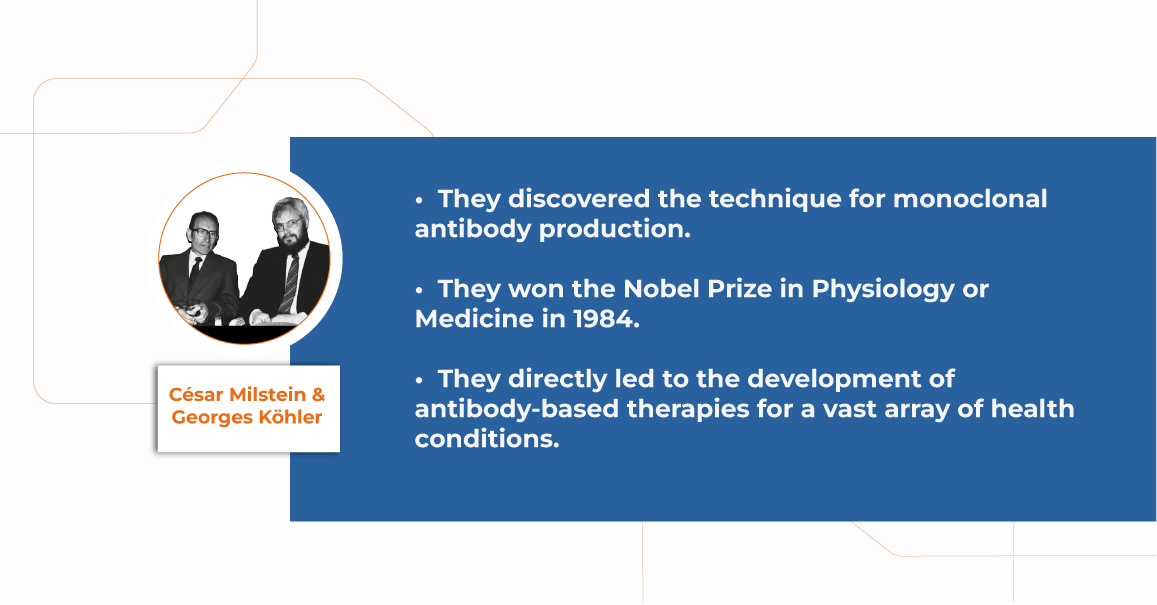Georges Köhler and César Milstein: The birth of monoclonal antibodies
- They discovered the technique for monoclonal antibody production.
- They won the Nobel Prize in Physiology or Medicine in 1984.
- They directly led to the development of antibody-based therapies for a vast array of health conditions.

Since their initial invention almost 50 years ago in 1975, monoclonal antibodies have been widely utilized in the biomedical industry. From cancer treatment to diagnostic assays, over 100 monoclonal antibodies have been approved by the FDA, making them a critical component of healthcare.
While researchers worldwide are working to advance monoclonal antibody therapies, there are two people to thank for the development of monoclonal antibodies: Georges Köhler and César Milstein, two men who significantly impacting disease treatment approaches.
Diverse upbringings united through a passion for biology
Georges Köhler was a German biologist, born in 1946 in Munich, Germany. After completing his PhD in biology from the University of Freiburg, Georges’ scientific career was pursued in 1974 in Cambridge at the Laboratory of Molecular Biology, where he worked as a post-doctoral research fellow. It was there that his scientific endeavors would forever be entwined with those of César Milstein.
Born in Argentina in 1927, César Milstein took a more scenic route in pursuit of his scientific career. César earned two PhDs in his lifetime, his first in Biochemistry in 1957 from the University of Buenos Aires, and the second in Biochemistry from the University of Cambridge in 1960. Following the completion of his PhD at Cambridge, Milstein eventually shifted his focus from enzymology to immunology, joining the Laboratory of Molecular Biology in 1963.
Paths crossed and history made
It was in the Laboratory of Molecular Biology that Köhler and Milstein’s paths crossed. Milstein had been investigating antibody diversity and the generation of antibodies with known specificity in myeloma cells. As a newly joined post-doctoral fellow in the lab, Köhler posed the hypothesis that spleen cells might be fused with myelomas to create immortal cell lines capable of specific antibody production.
Milstein was an enthusiastic supporter of Köhler’s hypothesis, and working together as a team, they successfully developed a method to create immortalized cell lines capable of producing specific monoclonal antibodies with unlimited capacity. This was a previously unimaginable achievement, at the time monoclonal antibody production techniques resulted in cell lines with low antibody titers.
A Nobel Prize for a noble discovery
While we now know the scope of such a discovery and its applications in medicine, at the time the implications were briefly overlooked. Köhler and Milstein published their findings in a Nature article in 1975, but it wasn’t until 1977 when the Lancet published an editorial lauding the discovery that the potential for hybridomas were realized.
The publicity generated in the scientific community as a result of the Lancet article helped lead to the early commercialization of hybridoma technologies. Shortly before the first FDA approval of a monoclonal antibody therapy for the treatment of kidney transplant rejection (Orthoclone OKT3), Köhler and Milstein were honored in 1984 with both the Albert Lasker Basic Medical Research Award and the Nobel Prize in Physiology or Medicine for their groundbreaking discovery.
Later career achievements
Following their success with hybridoma technology development in the 1970s, both Milstein and Köhler went on to have productive, far-reaching scientific careers.
Köhler continued to work on refining the production of monoclonal antibodies throughout the years, identifying additional myelomas for specific antibody production at the Basel Institute for Immunology in Switzerland. Returning to Germany in his later years, he worked to further elucidate B cell development, immunoglobulin expressions, and cytokine effects on the immune response as the Director of the Max Planck Institute for Immune Biology. Unfortunately, Georges Köhler died of a heart attack in 1995 at the age of 48.
Milstein also continued his work with monoclonal antibodies throughout the remainder of his career, with some of his research leading to the ability to utilize monoclonal antibodies as probes, or markers, of difference cell types. He was appointed as the head of the Protein and Nucleic Acid Chemistry Division at the Medical Research Council in 1983, and maintained that position until retiring in 1995. César Milstein went on to live out his retirement with his wife Celia before passing away aged 74 in 2002.
Continued contributions to immune therapies
While both Milstein and Köhler have passed away, their crucial discoveries in the field of monoclonal antibody techniques continue to pave the way for researchers today for therapeutic advancements, improving patient outcomes worldwide.
One such application in immunotherapy that would not be possible without the groundwork laid by Milstein and Köhler is the development of humanized monoclonal antibodies: antibodies that are made through genetic engineering that result in the combination of the constant domain of a human antibody with the variable domain(s) of a mouse monoclonal antibody. While hybridoma technology laid the groundwork for the development of therapeutic antibodies for various diseases, including cancers, autoimmune disorders, and infectious diseases and many of the first-generation therapeutic antibodies were developed using hybridoma technology, these antibodies were then humanized to enhance their safety and efficacy in humans. Humanized antibodies are unique in that they exhibit extended half-lives, allow for human effector functions to occur, and result in very little host immune response, making them superior therapeutic agents to traditional mouse monoclonal antibodies. They can be applied towards a multitude of target antigens, cancer treatment, immunosuppression, immunomodulation, pathogen killing, and treatment of autoimmune diseases. The first humanized monoclonal antibody was approved by the FDA in 1997, and to date, over 100 humanized antibodies have been described either for patent, or in scientific literature.

